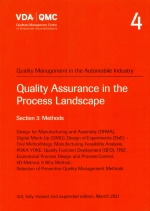Tab Article
The advancing developments in quality management in the automotive industry have required a complete revision of the VDA volume 4 both with regard to content as well as editorial.
Changes in content were mainly made in the following areas:
- Integration of a chapter on the 5 Why method
- Integration of the method selection model from the former VDA volume 14
- Summaries of the methods FMEA and 8D due to their transfer as detailed, independent VDA volumes
- Integration of further developments and new perceptions for various method descriptions
- Dissolving the ring-binder structure : This volume is now available as a monograph available in four sections, which improves clarity and easy referencing.
In the course of the editorial revision, references, sources and standard references have been updated, spelling, grammar and consistency have been verified and figures have been reworked.
Overview of the Sections of VDA Volume 4 – Quality Assurance in the Process Landscape:
- Section 1 : General. Methods Overview, Elementary Aids, Development Processes
- Section 2 : Risk Analyses. Fault Tree Analysis – FTA, Failure Mode and Effects Analysis (FMEA), SWOT Analysis (Strengths – Weaknesses – Opportunities – Threats)
- Section 3 : Methods. Design for Manufacturing and Assembly (DFMA), Digital Mock-Up (DMU), Design of Experiments (DoE) – Trial Methodology, Manufacturing Feasibility Analysis, POKA YOKE, Quality Function Deployment (QFD), TRIZ, Economical Process Design and Process Control, 8D Method, 5 Why Method, Selection of Preventive Quality Management Methods
- Section 4 : Process Models. Six Sigma, Design for Six Sigma (DFSS), Industrial Tolerance Process


